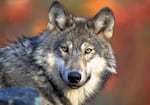
FILE - This photo provided by the U.S. Fish and Wildlife Service shows a gray wolf, April 18, 2008.
Gary Kramer / AP
Ecosystems in the Northwest were heavily shaped by wolves before they were nearly wiped out of the region, a new study finds.
By the 1930s, gray wolves were nearly gone in Oregon and the rest of the West, leading to the multiplication of animals the wolves hunted and creating an imbalance in the environment, researchers at Oregon State University found.
But the full impact of their disappearance isn’t fully understood because ecological research from the last century largely left out the role of wolves on the landscape. Most of the research wasn’t done until the wolves were nearly gone.
This means our understanding of natural ecosystems in the Northwest is flawed, according to William Ripple, an Oregon State ecologist and the lead author of the study. He said that hampers habitat restoration projects in the Northwest and moves, for example, to reintroduce more gray wolves in the West.
“Since the presence or absence of wolves can dramatically affect ecosystem structure and function, we believe this is a major issue for restoration, conservation and management,” Ripple said in an email.
The study was published recently in the journal BioScience.
Gray wolves are listed as endangered under the federal Endangered Species Act in most of central and western Oregon. Oregon’s population of gray wolves has only recently returned and grown following decades of absence. The first gray wolves to return to Oregon wandered into the eastern part of the state in the late 1990s, more than 50 years after they had been effectively hunted and pushed out of the U.S. By 2009, the wolf population in eastern Oregon became more established, but growth has leveled off.
The analysis looked into ecological studies between 1955 and 2021 at 11 national parks to see whether they mentioned or explored the effect of the wolves’ disappearance. Less than half – 39 of nearly 100 studies – included such data.
“We found that the historical presence of wolves was not considered in the majority of relevant publications that we analyzed,” he said.
Ripple said this lack of research has created a false baseline, with many scientists measuring ecosystem health based on the degraded conditions that spread after the wolves were gone. Without them, elk populations grew, leading to overgrazing; coyote numbers grew, shrinking populations of the small animals coyotes hunt; even trees struggled due to changes in animal populations and plant functions once the wolves were gone, the researchers found.
“The historical loss of wolves from Western landscapes is a major ecological issue,” he said.
Ripple and the researchers suggest more historical data needs to be identified and studied across the region to better understand the effect wolves and other large predators had on ecosystems in the Northwest and to adjust expectations of their health.
“It is important that we do not forget what ecosystems looked like before the loss of wolves. We need to document the shifting baseline and remember that we might now be studying landscapes that are a sick patient,” Ripple said.
Oregon Capital Chronicle is part of States Newsroom, a network of news bureaus supported by grants and a coalition of donors as a 501(c)(3) public charity. Oregon Capital Chronicle maintains editorial independence. Contact Editor Lynne Terry for questions: info@oregoncapitalchronicle.com . Follow Oregon Capital Chronicle on Facebook and X.